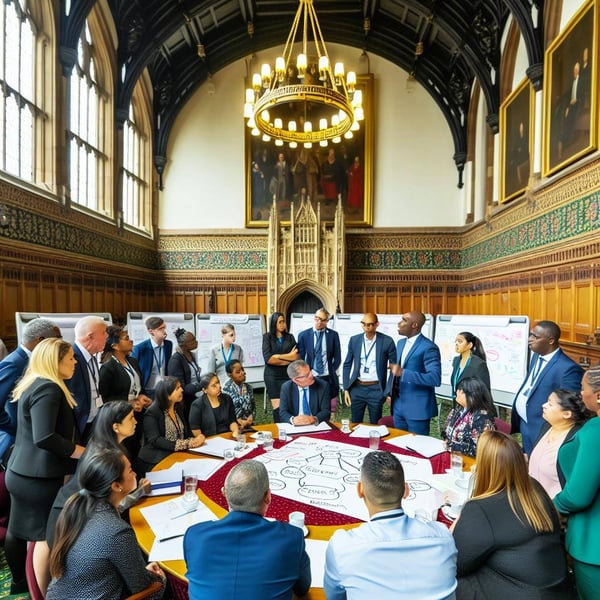Navigating the shift to the modern workplace
The Government Transformation Summit in November 2023 brought together delegates from the public, private and third sectors. The summit sought to inspire, spark curiosity, and challenge thinking around how best to improve people’s lives when digital capabilities are moving at pace and fundamentally changing how we all work.
As part of the summit, Cognizant hosted a round table to debate the future of the Digital Workplace, where we delved into a variety of topics to explore the opportunities aligned to the ‘future of work’. We focused on what it means for government, what is needed to modernise government and what leaders should focus on when everything feels like a priority. We posed a pivotal question to delegates as to how ‘truly’ ready they were to tackle the future of the Digital Workplace as gen AI sweeps across the global stage in both private and public sectors.
Becoming future-ready
It’s clear something big is happening to the economy, for business, government, society, people’s livelihoods and the way we work. Change is a given, so as government continues to modernise it’s evident that gen AI will be at its heart and fundamentally change the global public services workplace. As Anna Wong, Treasury Board of Canada Secretariat, explained in her plenary session “What it is today is not what it is tomorrow”.
Being future-ready means being ready for anything. New technologies hold many of the answers to helping the public sector modernise and work differently. However, despite the significant financial pressures, investing in technology is often the easier part. It’s using the technology effectively to realise its benefits that is often more difficult. That’s because all organisations can easily overlook the most important factors for success—readiness for change and people.
AI readiness and adoption
The lightning-fast pace of technological change since the introduction of the Internet in the 1990s underscores the transformative potential of gen AI. Yet, while technology holds promise, success hinges on cultivating an engaged, digitally proficient workforce, which comes at a time when the technology itself is setting the stage for a profound shift in increased productivity expectations and how we approach work. Our recent research with Oxford Economics found that generative AI will potentially disrupt up to 90% of existing jobs – so how will government prepare for this level of disruption?
Gen AI is already augmenting and automating many work tasks. It is set to shape how government organisations approach work, measure productivity, deliver services and govern the workplace and engagement with employees and citizens. The ever-changing digital landscape will mean constant change and undoubtedly impact actual people, actual jobs and actual careers.
The route to successful adoption is to create the right culture, incentives and institutional support that fosters engaged, motivated and satisfied employees who can adapt to and embrace this new world of work. This is a difficult task and will be made more so by an ever-changing digital landscape. It’s important for organisations to focus on upskilling and reskilling to retain the trust of workers and ensure that technologies are adopted in a strategic way with maximum employee engagement.
Overcoming barriers to innovation
One of the most common concerns among all organisations is ‘how ready are we to take advantage’ and embrace these new ways of working and new technologies. The obstacles to innovation range from cultural resistance to the burden of legacy processes and systems as well as a lack of relevant education in the workplace. Government organisations need to fully understand the potential of new technologies to undertake a realistic assessment of the value they bring versus the associated business risks. But here's the catch: old legacy systems are still holding back progress. The need to ‘clean the house’, understand purpose, aims and objectives, establish effective controls, and define clear outcomes before experimenting with new techniques to realise true value is the key to effectively adopting and implementing these ‘game changing’ technologies.
The key to successful innovation over the years has been focusing on business problems and the needs of customers. The impact of digital on the outside world is clear, with shifts to e-channels the norm in everything from shopping, online banking to government services, makes this increasingly imperative. However, government organisations must reevaluate their core activities to continuously adapt to the digital trends among their customers, citizens and employees. They need to think about designing their organisations around the ‘digital voice of the customer’ to break down cultural and organisational barriers.
Key considerations for a modern workplace
Our research found that the more disruption workers face, the more difficult it is for them to adapt to new ways of working. High levels of disruption can have severe consequences, not only for the organisation and the people who work in them but also for productivity. To ensure high levels of productivity, organisations must closely monitor three things:
- Being ready for change
- The rate of adoption of generative AI
- Disengagement or displacement of employees
Trust is key here—trust between the employer and employee and trust in the technology itself. If employers succeed, we could be entering an age of improved productivity, employee engagement and satisfaction with greater efficiency and effectiveness.
Achieving synergies across people, processes and technology
In our experience, meaningful progress occurs when organisations empower their workforce, by prioritising personalised experiences, hybrid working model and re-skilling initiatives to effectively prepare their employees for new technologies and ways of working.
Utilising AI can enhance personalisation, productivity and citizen experiences while fostering greater employee trust by integrating business expertise with intelligent digital platforms. The rapid adoption of these transformative technologies can and will unlock the full potential of the Digital Workforce.
So, when it comes to the current state of future-readiness across the public sector, the picture is mixed. Public sector leaders must shift towards a mindset akin to venture capitalists, embracing new practices while supporting their teams. As Joanne Rowland, Director General for the Customer Services Group at the Home Office, highlighted in her keynote speech at the GTM summit, government organisations must do things differently and their ambition to make public services world-class is challenging and not for the faint-hearted. She went on to say that the Departments must focus on better understanding what the ‘it’ is and generally manage their operations ‘better’, particularly when it comes to re-contracting, transforming and driving innovation.






